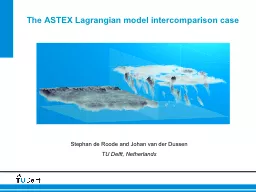PPT-The ASTEX
Author : myesha-ticknor | Published Date : 2016-10-07
Lagrangian model intercomparison case Stephan de Roode and Johan van der Dussen TU Delft Netherlands The ASTEX First Lagrangian June 1992 Lagrangian evolution
Presentation Embed Code
Download Presentation
Download Presentation The PPT/PDF document "The ASTEX" is the property of its rightful owner. Permission is granted to download and print the materials on this website for personal, non-commercial use only, and to display it on your personal computer provided you do not modify the materials and that you retain all copyright notices contained in the materials. By downloading content from our website, you accept the terms of this agreement.
The ASTEX: Transcript
Download Rules Of Document
"The ASTEX"The content belongs to its owner. You may download and print it for personal use, without modification, and keep all copyright notices. By downloading, you agree to these terms.
Related Documents


